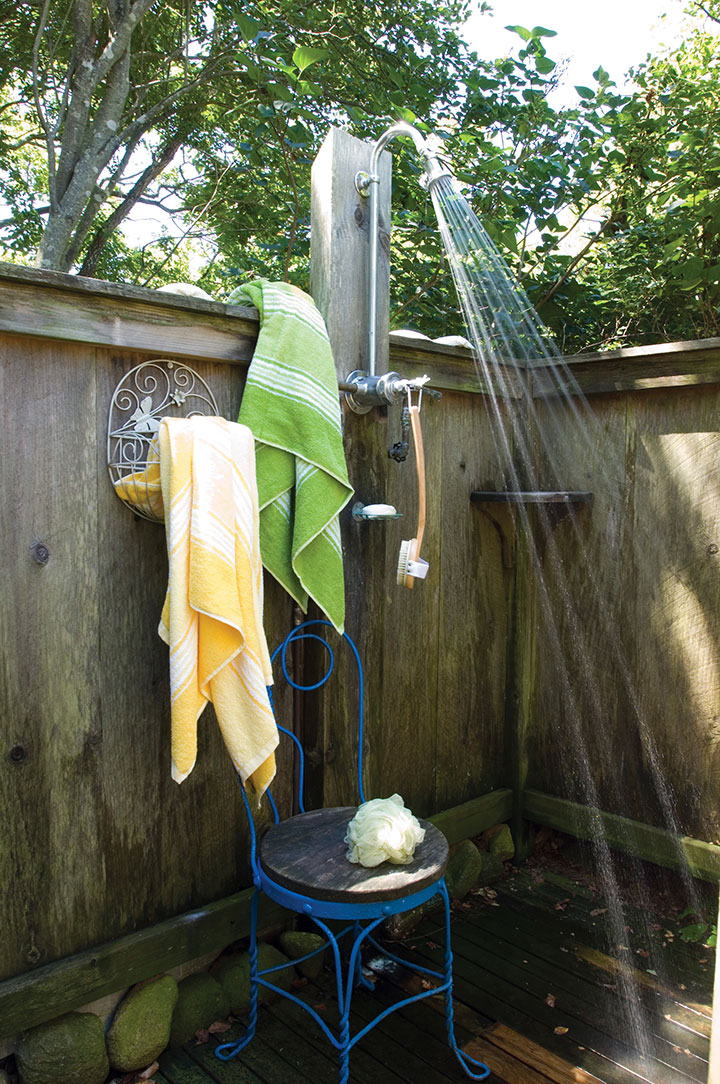Build an Outdoor Shower
A Block Island couple gives the post-beach rinse an elegant twist with this outdoor shower. PROJECT: BUILD AN OUTDOOR SHOWER Guests who get a chance to use the outdoor shower at the Block Island home of Larry Breakstone and his wife, Karen Levey, come away impressed. And for good reason: For starters, it’s got hot […]

Coffee By Design | Portland, Maine
Photo Credit : Katherine KeenanA Block Island couple gives the post-beach rinse an elegant twist with this outdoor shower.

Photo Credit : Erik Rank
PROJECT: BUILD AN OUTDOOR SHOWER
Guests who get a chance to use the outdoor shower at the Block Island home of Larry Breakstone and his wife, Karen Levey, come away impressed. And for good reason: For starters, it’s got hot water, but the 4×8-foot structure is also spacious, offers a pleasant view of Block Island Sound, and is extremely private, thanks to an array of hydrangeas, lilacs, rosebushes, and other flowering plants that have grown up around the shower’s 5-foot walls. But its creation didn’t come about without careful planning.
Larry and Karen were especially concerned with making sure the small building didn’t interrupt the lines of their recently constructed post-and-beam house. So, they set it off on its own on the southwest corner of the property, where it receives full afternoon sun. A short fieldstone path connects it to the house. “We’ll shower out there until November,” Karen quips.
PROCESS:
To create a durable “superstructure,” Larry, who did all of the work himself, drove five nontoxic, pressure-treated 4×4-inch posts two feet into the ground to demarcate the corners and the door. Then he connected them with a series of lateral posts top and bottom. The lower crosspieces are a few feet aboveground to block out leaves and other debris; Larry filled the gap with a loose-fitting collection of beach stones. For sheathing, he decided against plywood and went for a barn-board look, running 1×12-inch rough-cut pine vertically. Why? “We knew they’d age and color to match our gray cedar-sided home,” he says. “Plus, plywood deteriorates faster.”
To avert water from getting into the siding’s end grain and rotting it out, Larry capped the top with a 4-inch-wide pine board. But his preventive measures didn’t stop there. Worried that soapy water might find its way into the home’s nearby well, he poured a shallow, square cement foundation with catch basin, from which a buried PVC pipe runs to a French drain 30 feet away. (The shower’s flooring—1×3-inch oak, spaced a quarter-inch apart—lets discharged water seep into the basin.) Design elements include a whitewashed shed door the couple picked up at a recycling center, and, mounted on a 4×10-inch post, a brass gooseneck showerhead and matching knobs that a friend had saved during renovation of a nearby hospital
WHAT DO YOU LIKE MOST?
“It’s just a nice way to end a day at the beach,” Larry says. “It’s big, it’s open, you’re surrounded by all these wonderful plants, and sand doesn’t get tracked inside.”
COST:
Construction materials, including lumber and antique fixtures, totaled $250. Larry estimates that he put in about eight hours of work.
Have you completed a home project that you’d like to see in Yankee Plus? We’ll pay $100 for every one selected. Email: Plus@YankeePub.com








How do you winter proof this shower?
Great question, Amy. The shower is made with pressure treated posts and barn boards, both of which can better withstand the elements better than say finished pine or plywood. Once the weather turns cold, however, the water is turned off so the pipes don’t freeze. Think of it as a late spring, summer, and early fall shower.
Hot and cold shut offs inside the house along with a drain plug soldered into the outside piping
How does the water get to the shower? Where is the hot water made? How is it winter proofed? This article isn’t so much about building a shower as it is about building a roofless shed. All of the important work about the shower and water supply are neglected. I understand that details about plumbing can’t be included in a magazine article like this, but some basic ideas should be included.
Thanks for your question, Bob. The water is actually plumbed into the home’s water system. Which means it’s heated from the same hot water that heats the water that runs in the rest of his house. The owner installed water lines (most likely PEX tubing, rather than copper) from the shower to the basement.